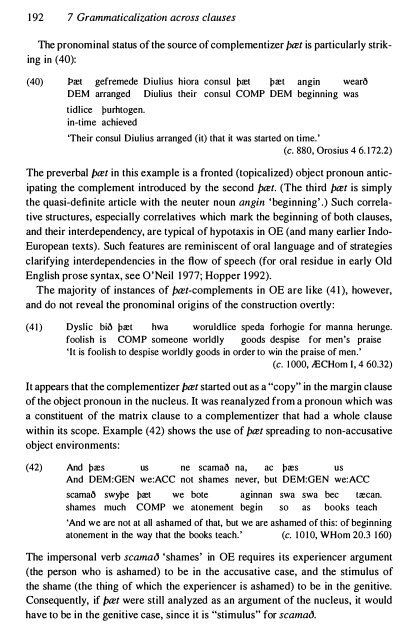Gram - SEAS
Gram - SEAS
Gram - SEAS
Create successful ePaper yourself
Turn your PDF publications into a flip-book with our unique Google optimized e-Paper software.
192 7 <strong>Gram</strong>maticalization across clauses<br />
The pronominal status of the source of complementizer pret is particularly striking<br />
in (40):<br />
(40) l>ret gefremede Diulius hiora consul t>ret t>ret<br />
DEM arranged Diulilis their consul COMP DEM<br />
tidlice t>urhtogen.<br />
in-time achieved<br />
angin weaf(<br />
beginning was<br />
'Their consul Diulius arranged (it) that it was started on time.'<br />
(c. 880, Orosius 4 6. 1 72.2)<br />
The preverbal pret in this example is a fronted (topicalized) object pronoun antic<br />
ipating the complement introduced by the second pret. (The third pret is simply<br />
the quasi-definite article with the neuter noun angin 'beginning'.) Such correla<br />
tive structures, especially correlatives which mark the beginning of both clauses,<br />
and their interdependency, are typical of hypotaxis in OE (and many earlier Indo<br />
European texts). Such features are reminiscent of oral language and of strategies<br />
clarifying interdependencies in the flow of speech (for oral residue in early Old<br />
English prose syntax, see O'Neil 1977; Hopper 1992).<br />
The majority of instances of pret-complements in OE are like (4 1), however,<br />
and do not reveal the pronominal origins of the construction overtly:<br />
(41) Dyslic bia t>ret hwa woruldlice speda forhogie for manna herunge.<br />
foolish is COMP someone worldly goods despise for men's praise<br />
'It is foolish to despise worldly goods in order to win the praise of men.'<br />
(c. 1000, IECHom I, 4 60.32)<br />
It appears that the complementizer pret started out as a "copy" in the margin clause<br />
of the object pronoun in the nucleus. It was reanalyzed from a pronoun which was<br />
a constituent of the matrix clause to a complementizer that had a whole clause<br />
within its scope. Example (42) shows the use of pret spreading to non-accusative<br />
object environments:<br />
(42) And t>res us ne scamaa na, ac t>res us<br />
And DEM:GEN we:ACC not shames never, but DEM:GEN we:ACC<br />
scamaa swyt>e t>ret we bote aginnan swa swa bec trecan.<br />
shames much COMP we atonement begin so as books teach<br />
'And we are not at all ashamed of that, but we are ashamed of this: of beginning<br />
atonement in the way that the books teach.' (c. 1010, WHom 20.3 160)<br />
The impersonal verb scamaiJ 'shames' in OE requires its experiencer argument<br />
(the person who is ashamed) to be in the accusative case, and the stimulus of<br />
the shame (the thing of which the experiencer is ashamed) to be in the genitive.<br />
Consequently, if pret were still analyzed as an argument of the nucleus, it would<br />
have to be in the genitive case, since it is "stimulus" for scamaiJ.
















